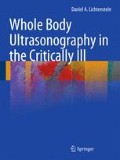Abstract
The acute incapacity to breathe normally is one of the most distressing situations one can live with [1]. The BLUE protocol unites 18 years of efforts (mainly repeated submissions) aimed at relieving these suffocating patients. The idea of performing an ultrasound examination on such patients was not routine in 1989. Our approach possibly intrigued some doctors and nurses in the emergency rooms of our institutions. During management of these critical situations, there was not time for quiet explanations, and the tired emergency doctors, after duty, rushed for a deserved nap, therefore turning their backs on this potential. What these colleagues did not fully see was that, after a few minutes, we were able to give the nurses therapeutic options while organizing the transfer to the ICU. And what they did not see at all (occupied by a thousand other tasks) was that these options were in accordance with the final diagnosis. The publication of the BLUE protocol was one of the three main reasons, along with Chaps. 21 and 23, that justified this 2010 edition. The tools that are usually used in the emergency setting, i.e., the physical examination [2] and radiography [3], are not very precise. The crowded emergency room is not the ideal place for a serene and efficient diagnosis – an acknowledged issue [4–8]. One-quarter of the patients of the BLUE protocol in the first 2 h of management receive erroneous or uncertain initial diagnoses, and many more receive inappropriate therapy. The on-line document of Chest 134:117–125 details these 26% of wrong diagnoses. CT seems to be a solution, but Chap. 19 has already demonstrated its heavy drawbacks. One day, the community may find this tool to be too irradiating [9].
Access this chapter
Tax calculation will be finalised at checkout
Purchases are for personal use only
References
Irwin RS, Rippe JM (2008) Intensive care medicine, 6th edn. Lippincott Williams & Wilkins, Philadelphia, pp 491–496
Laënnec RTH (1819) Traité de l’auscultation médiate, ou traité du diagnostic des maladies des poumons et du cœur. J.A. Brosson & J.S. Chaudé, Paris. Hafner, New York, 1962, pp 455–456
Roentgen WC (1895) Ueber eine neue Art von Strahlen. Vorlaüfige Mittheilung, Sitzungsberichte der Würzburger Physik-mediz Gesellschaft 28:132–141
Wasserman K (1982) Dyspnea on exertion: is it the heart or the lungs? J Am Med Assoc 248:2039–2043
Greenbaum DM, Marschall KE (1982) The value of routine daily chest X-rays in intubated patients in the medical intensive care unit. Crit Care Med 10:29–30
Aronchick J, Epstein D, Gefter WB et al (1985) Evaluation of the chest radiograph in the emergency department patient. Emerg Med Clin North Am 3:491–501
Lichtenstein D, Goldstein G, Mourgeon E, Cluzel P, Grenier P, Rouby JJ (2004) Comparative diagnostic performances of auscultation, chest radiography and lung ultrasonography in acute respiratory distress syndrome. Anesthesiology 100:9–15
Ray P, Birolleau S, Lefort Y, Becquemin MH, Beigelman C, Isnard R, Teixeira A, Arthaud M, Riou B, Boddaert J (2006) Acute respiratory failure in the elderly: etiology, emergency diagnosis and prognosis. Crit Care 10(3):R82
Brenner DJ, Hall EJ (2007) Computed tomography. An increasing source of radiation exposure. New Engl J Med 357:2277–2284
Staub NC (1974) Pulmonary edema. Physiol Rev 54:678–811
Safran D, Journois D (1995) Circulation pulmonaire. In: Samii K (ed) Anesthésie réanimation chirurgicale, 2nd edn. Flammarion, Paris, pp 31–38
Lichtenstein D, Mezière G, Biderman P, Gepner A, Barré O (1997) The comet-tail artifact, an ultrasound sign of alveolar-interstitial syndrome. Am J Respir Crit Care Med 156:1640–1646
Rémy-Jardin M, Rémy J (1995) Œdème interstitiel. In: Rémy-Jardin M, Rémy J (eds) Imagerie nouvelle de la pathologie thoracique quotidienne. Springer, Paris, pp 137–143
Laënnec RTH (1819) Traité de l’auscultation médiate, ou traité du diagnostic des maladies des poumons et du cœur. J.A. Brosson & J.S. Chaudé, Paris. Hafner, New York, 1962
Lichtenstein D, Mezière G, Lagoueyte JF, Biderman P, Goldstein I, Gepner A (2009) A-lines and B-lines: lung ultrasound as a bedside tool for predicting pulmonary artery occlusion pressure in the critically ill. Chest 136:1014–1020
Khosla R (2009) Utility of lung sonography in acute respiratory failure. Chest 135:884
Mathis G, Blank W, Reißig A, Lechleitner P, Reuß J, Schuler A, Beckh S (2001) Thoracic ultrasound for diagnosing pulmonary embolism. Chest 128:1531–1538
Volpicelli G, Cardinale L, Mussa A, Caramello V (2009) Diagnosis of cardiogenic pulmonary edema by sonography limited to the anterior lung. Chest 135:883
SLAM – Section pour la Limitation des Acronymes en Médecine (2009) – Déclaration 1609. 1er avril 2008. Journal Officiel de la République Française, 26 avril 2008 (N° 17), p 2009
Lichtenstein D, Axler O (1993) Intensive use of general ultrasound in the intensive care unit, a prospective study of 150 consecutive patients. Intensive Care Med 19:353–355
Lichtenstein D (1995) Echographie pulmonaire. Diplôme Inter-Universitaire National d’Echographie, Paris VI, December, 1995
Lichtenstein D, Mezière G (2003) Ultrasound diagnosis of an acute dyspnea. Crit Care 7(Suppl 2):S93
Lichtenstein D (2005) Analytic study of frequent and/or severe situations. In: General ultrasound in the critically ill. Springer, Berlin, pp 177–183
Author information
Authors and Affiliations
Corresponding author
Rights and permissions
Copyright information
© 2010 Springer-Verlag Berlin Heidelberg
About this chapter
Cite this chapter
Lichtenstein, D.A. (2010). Basic Applications of Lung Ultrasound in the Critically Ill: 2 – The Ultrasound Approach of an Acute Respiratory Failure: The BLUE Protocol. In: Whole Body Ultrasonography in the Critically Ill. Springer, Berlin, Heidelberg. https://doi.org/10.1007/978-3-642-05328-3_20
Download citation
DOI: https://doi.org/10.1007/978-3-642-05328-3_20
Published:
Publisher Name: Springer, Berlin, Heidelberg
Print ISBN: 978-3-642-05327-6
Online ISBN: 978-3-642-05328-3
eBook Packages: MedicineMedicine (R0)

